ZHCSF90D August 2012 – June 2016 LP5560
PRODUCTION DATA.
- 1 特性
- 2 应用
- 3 说明
- 4 修订历史记录
- 5 Pin Configuration and Functions
- 6 Specifications
-
7 Detailed Description
- 7.1 Overview
- 7.2 Functional Block Diagram
- 7.3 Feature Description
- 7.4 Device Functional Modes
- 7.5 Programming
- 7.6 Registers
- 8 Application and Implementation
- 9 Power Supply Recommendations
- 10Layout
- 11器件和文档支持
- 12机械、封装和可订购信息
6 Specifications
6.1 Absolute Maximum Ratings
over operating free-air temperature range (unless otherwise noted)(1)(2)(3)| MIN | MAX | UNIT | ||
|---|---|---|---|---|
| Voltage on VDD pin | −0.3 | 6 | V | |
| Voltage on other pins (CTRL,LED)(4) | −0.3 | VDD + 0.3 V with 6 V maximum | V | |
| Continuous power dissipation(5) | Internally Limited | |||
| Junction temperature, TJ-MAX | 125 | °C | ||
| Storage temperature, Tstg | −65 | 150 | °C | |
(1) Stresses beyond those listed under Absolute Maximum Ratings may cause permanent damage to the device. These are stress ratings only, which do not imply functional operation of the device at these or any other conditions beyond those indicated under Recommended Operating Conditions. Exposure to absolute-maximum-rated conditions for extended periods may affect device reliability.
(2) All voltages are with respect to the potential at the GND pins.
(3) If Military/Aerospace specified devices are required, contact the Texas Instruments Sales Office/ Distributors for availability and specifications. Voltage
(4) Undervoltage lockout (UVLO) shuts down the LED driver with VIN drops to 2.3 V (typical). Power-on reset (POR) trips at VIN = 2 V (typical).
(5) Internal thermal shutdown circuitry protects the device from permanent damage. Thermal shutdown engages at TJ = 160°C (typical) and disengages at TJ=140°C (typical).
6.2 ESD Ratings
| VALUE | UNIT | |||
|---|---|---|---|---|
| V(ESD) | Electrostatic discharge | Human-body model (HBM), per ANSI/ESDA/JEDEC JS-001(1) | ±2000 | V |
| Charged-device model (CDM), per JEDEC specification JESD22-C101(2) | ±1000 | |||
(1) JEDEC document JEP155 states that 500-V HBM allows safe manufacturing with a standard ESD control process.
(2) JEDEC document JEP157 states that 250-V CDM allows safe manufacturing with a standard ESD control process.
6.3 Recommended Operating Conditions
over operating free-air temperature range (unless otherwise noted)(1)(2)| MIN | NOM | MAX | UNIT | ||
|---|---|---|---|---|---|
| Voltage on power pin (VDD) | 2.7 | 5.5 | V | ||
| Junction temperature, TJ | −30 | 125 | °C | ||
| Ambient temperature, TA(1) | −30 | 85 | °C | ||
(1) In applications where high power dissipation and/or poor package thermal resistance is present, the maximum ambient temperature may have to be derated. Maximum ambient temperature (TA-MAX) is dependent on the maximum operating junction temperature (TJ-MAX-OP = 125°C), the maximum power dissipation of the device in the application (PD-MAX), and the junction-to ambient thermal resistance of the part/package in the application (RθJA), as given by the following equation: TA-MAX = TJ-MAX-OP – (RθJA × PD-MAX).
(2) All voltages are with respect to the potential at the GND pin.
6.4 Thermal Information
| THERMAL METRIC(1) | LP5560 | UNIT | |
|---|---|---|---|
| YFQ (DSBGA) | |||
| 4 PINS | |||
| RθJA | Junction-to-ambient thermal resistance | 184.3 | °C/W |
| RθJC(top) | Junction-to-case (top) thermal resistance | 1.8 | °C/W |
| RθJB | Junction-to-board thermal resistance | 103.2 | °C/W |
| ψJT | Junction-to-top characterization parameter | 9.1 | °C/W |
| ψJB | Junction-to-board characterization parameter | 103.1 | °C/W |
(1) For more information about traditional and new thermal metrics, see Semiconductor and IC Package Thermal Metrics.
6.5 Electrical Characteristics
Unless otherwise specified: VIN = 3.6 V, CTRL = 3.6 V, VLED = 3.1 V; typical limits are for TA = 25°C, and minimum and maximum limits apply over the operating ambient temperature range (−30°C < TA < +85°C).(1)(2)| PARAMETER | TEST CONDITIONS | MIN | TYP | MAX | UNIT | |
|---|---|---|---|---|---|---|
| ISD | Shutdown supply current | CTRL = 0 V | 0.4 | 0.75 | µA | |
| IQ | Quiescent supply current | ILED = 0 mA | 25 | 30 | ||
| ILED | LED output current | ISET = 0 | 2.26 | 2.8 | 3.34 | mA |
| ISET = 1 (default) | 4.61 | 5.3 | 5.99 | |||
| ISET = 2 | 6.78 | 7.8 | 8.82 | |||
| ISET = 3 | 8.87 | 10.2 | 11.53 | |||
| ISET = 4 | 10.96 | 12.6 | 14.24 | |||
| ISET = 5 | 13.5 | 15.0 | 16.5 | |||
| ISET = 6 | 15.05 | 17.3 | 19.55 | |||
| ISET = 7 | 16.96 | 19.5 | 22.04 | |||
| ΔILED%/ΔVIN | Line regulation | 2.7 V ≤ VIN ≤ 4.5 V | –3% | 3% | %/1V | |
| IDX = 5.3 mA, Vƒ = 2.5 V | ||||||
| ΔILED%/ΔVLED(3) | Load regulation | 1.7 V ≤ VLED ≤ 3.4 V, ILED = 5.3 mA | 0.6 | |||
| VHR | Headroom voltage(4) | ILED = 5.3 mA | 40 | 100 | mV | |
| ILED = 19.5 mA | 40 | |||||
| VIH | Logic input high level | VIN = 2.7 V to 5.5 V | 1.1 | V | ||
| VIL | Logic input low level | VIN = 2.7 V to 5.5 V | 0.6 | V | ||
| ICTRL | CTRL pin leakage current | CTRL = 1.8 V | 400 | nA | ||
| T_cycle_H | LED On time | Adjustable(5), TA = 25°C | 13.2 | 3009.6 | ms | |
| T_cycle_L | LED OFF time | 26.4 | 6019.2 | ms | ||
| Trise | LED current rise time(6) | 0 | 1584 | ms | ||
| Tfall | LED current fall time(6) | 0 | 1584 | ms | ||
| Fade resolution | Rise/fall time resolution | See(5) | 105.6 | ms | ||
(1) All voltages are with respect to the potential at the GND pins.
(2) Minimum and Maximum limits are specified by design, test, or statistical analysis. Typical numbers are not ensured, but do represent the most likely norm.
(3) ILED = LED output current, VLED = LED forward voltage.
(4) For LED output pin, headroom voltage is defined as the voltage across the internal current source when the LED current has dropped 10% from the value measured at VIN – 0.5 V. If headroom voltage requirement is not met, LED current regulation is compromised.
(5) Specified by design.
(6) LED current ramp-up and ramp-down uses a combined PWM-current adjustment.
6.6 Single-Wire Interface Timing Requirements
See (1)(2) and Figure 1| MIN | MAX | UNIT | ||
|---|---|---|---|---|
| TC_ON | Command pulse on time | 15 | µs | |
| TC_OFF | Command pulse off time | 30 | µs | |
| TT_ON | Minimum training pulse on time(3) | 200 | µs | |
| TT_OFF | Minimum training pulse off time(4) | 200 | µs | |
| TCAL | Calibration pulse length | 0.35 | 8 | ms |
| T ENTER | Command entering period | 500 | µs | |
| T ENTER+T BLANK | Command entering period + Blank period | 1500 | µs | |
(1) Specified by design.
(2) Minimum and Maximum limits are specified by design, test, or statistical analysis. Typical numbers are not ensured, but do represent the most likely norm.
(3) All CTRL signal high times between calibration pulse and training end are considered as training pulse on times.
(4) All CTRL signal low times between calibration pulse and training end are considered as training pulse off times.
 Figure 1. Interface Timing
Figure 1. Interface Timing
6.7 Typical Characteristics
TJ = 25°C. Unless otherwise noted, typical characteristics apply to the Functional Block Diagram with: VIN = 3.6 V, RISET = 24 kΩ, CIN = 100 nF.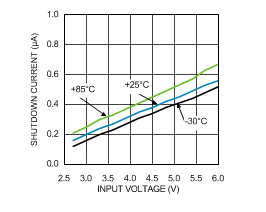
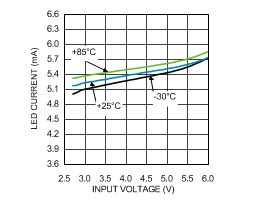
| 5 mA |
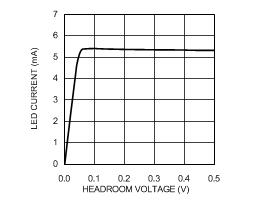
| 5 mA |
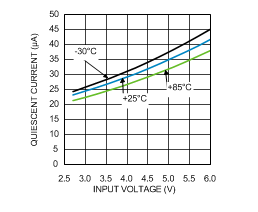
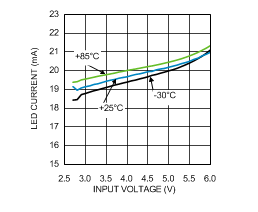
| 20 mA |
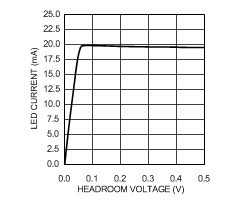
| 20 mA |